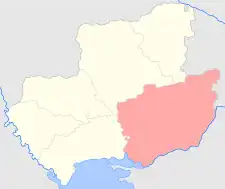Kherson uezd
Херсонскій уѣздъ | |
|---|---|
 Coat of arms | |
 Location in the Kherson Governorate | |
| Country | Russian Empire |
| Governorate | Kherson |
| Established | 1776 |
| Abolished | 1923 |
| Capital | Kherson |
| Area | |
| • Total | 19,553.04 km2 (7,549.47 sq mi) |
| Population (1897) | |
| • Total | 587,804 |
| • Density | 30/km2 (78/sq mi) |
| • Urban | 27.77% |
| • Rural | 72.23% |
The Kherson uezd[lower-alpha 1] was a county (uezd) of the Kherson Governorate of the Russian Empire, and then of the Ukrainian People's Republic and the Ukrainian SSR until the administrative reform of 1923. The uezd bordered the Odessa uezd to the west, the Elisavetgrad uezd to the northwest, the Aleksandriya uezd to the north, the Verkhnedneprovsk and Yekaterinoslav uezds of the Yekaterinoslav Governorate to the east, the Melitopol and Dneprovsk uezds of the Taurida Governorate, and the Black Sea to the south. The district was eponymously named for its administrative center, Kherson.
Administrative divisions
The subcounties (volosts) of the Kherson uezd in 1912 were as follows:[1]
| Name | Name in Russian | Capital |
|---|---|---|
| Alexandrovka volost | Александровская волость | Alexandrovka |
| Antonovka volost | Антоновская волость | Antonovka |
| Balatskoe volost | Балацковская волость | Balatskoe |
| Belozerka volost | Бѣлозерская волость | Belozerka |
| Vavilovka volost | Вавиловская волость | Vavilovka |
| Vladimirovka volost | Владиміровская волость | Vladimirovka |
| Grushevka volost | Грушевская волость | Grushevka |
| Gurevka volost | Гурьевская волость | Gurevka |
| Zagradovka volost | Заградовская волость | Zagradovka |
| Zaselye volost | Засельская волость | Zaselye |
| Zolotaya Balka volost | Затоло-Балковская волость | Zolotaya Balka |
| Kazatskoe volost | Казацкая волость | Kazatskoe |
| Kaluzhskoe volost | Калужская волость | Kaluzhskoe |
| Kamyanka volost | Камянская волость | Kamyanka |
| Kachkarovka volost | Качкаровская волость | Kachkarovka |
| Kislyakovka volost | Кисляковская волость | Kislyakovka |
| Krivoy Rog volost | Криворогская волость | Krivoy Rog |
| Kronau volost | Кронауская волость | Kronau |
| Lyubomirka volost | Любомирская волость | Lyubomirka |
| Maryinskoe volost | Марьинская волость | Maryinskoe |
| Mikhailovka volost | Михайловская волость | Mikhailovka |
| Nikolaevka 1-aya volost | Николаевская 1-я волость | Nikolaev 1-aya |
| Nikolaevka 2-aya volost | Николаевская 2-я волость | Nikolaev 2-aya |
| Nikolskoe volost | Никольская волость | Nikolskoe |
| Novyi Bug volost | Ново-Бугская волость | Novyi Buh |
| Novo-Vorontsovka volost | Ново-Воронцовская волость | Novovorontsovka |
| Novo-Nikolaevka volost | Ново-Николаевская волость | Novo-Nikolaevka |
| Novaya Odessa volost | Ново-Одесская волость | Novaya Odessa |
| Orlaph volost | Орлафская волость | Orlaph |
| Otbedovasilevka volost | Отбѣдовасильевская волость | Otbedovasilevka |
| Pokrovskoe volost | Покровская волость | Pokrovskoe |
| Poltavka volost | Полтавская волость | Poltavka |
| Privolnoe volost | Привольнянская волость | Privolnoe |
| Stanislav volost | Станиславская волость | Stanislav |
| Staroshvedskoe volost | Старошведская волость | Staroshvedskoe |
| Ternovka volost | Терновская волость | Ternovka (now neighborhood of Mykolaiv) |
| Tyaginka volost | Тягинская волость | Tyaginka |
| Shirokoe volost | Широковская волость | Shyroke |
Demographics
At the time of the Russian Empire Census on 28 January [O.S. 15 January] 1897, the Kherson uezd had a population of 587,804, including 302,002 men and 285,502 women. The majority of the population indicated Little Russian[lower-alpha 2] to be their mother tongue, with significant Russian, Jewish, and German speaking minorities.[4]
| Language | Native speakers | Percentage |
|---|---|---|
| Ukrainian[lower-alpha 2] | 323,627 | 55.06 |
| Russian[lower-alpha 2] | 144,623 | 24.60 |
| Jewish | 69,674 | 11.85 |
| German | 20,290 | 3.45 |
| Belarusian[lower-alpha 2] | 12,558 | 2.14 |
| Polish | 5,152 | 0.88 |
| Romanian | 4,953 | 0.84 |
| Bulgarian | 3,575 | 0.60 |
| Tatar | 1,057 | 0.18 |
| Swedish | 501 | 0.09 |
| Greek | 295 | 0.05 |
| Gypsy | 235 | 0.04 |
| Czech | 192 | 0.03 |
| Armenian | 141 | 0.02 |
| French | 139 | 0.02 |
| Latvian | 129 | 0.02 |
| English | 93 | 0.01 |
| Turkish | 91 | 0.01 |
| Italian | 68 | 0.01 |
| South Slavic | 63 | 0.01 |
| Estonian | 60 | 0.01 |
| Lithuanian | 38 | 0.00 |
| Mordovian | 26 | 0.00 |
| Georgian | 5 | 0.00 |
| Others | 119 | 0.02 |
| Total | 587,804 | 100.00 |
Notes
- ↑
- 1 2 3 4 Prior to 1918, the Imperial Russian government classified Russians as the Great Russians, Ukrainians as the Little Russians, and Belarusians as the White Russians. After the creation of the Ukrainian People's Republic in 1918, the Little Russians identified themselves as "Ukrainian".[2] Also, the Belarusian Democratic Republic which the White Russians identified themselves as "Belarusian".[3]
References
- ↑ Волостныя, станичныя, сельския, гминныя правления и управления, а также полицейские станы всей России с обозначением места их нахождения [Volostny, stanichnaya, rural, communes of government and administration, as well as police camps throughout Russia with the designation of their location]. Kiev: Izd-vo T-va L. M. Fish. 1913. p. 191. Archived from the original on 2022-12-11.
- ↑ Hamm, Michael F. (2014). Kiev: A Portrait, 1800–1917. Princeton University Press. p. 83. ISBN 978-1-4008-5151-5.
- ↑ Fortson IV, Benjamin W. (2011). Indo-European Language and Culture: An Introduction. John Wiley & Sons. p. 429. ISBN 978-1-4443-5968-8.
- 1 2 "Демоскоп Weekly - Приложение. Справочник статистических показателей". www.demoscope.ru. Retrieved 2019-12-20.